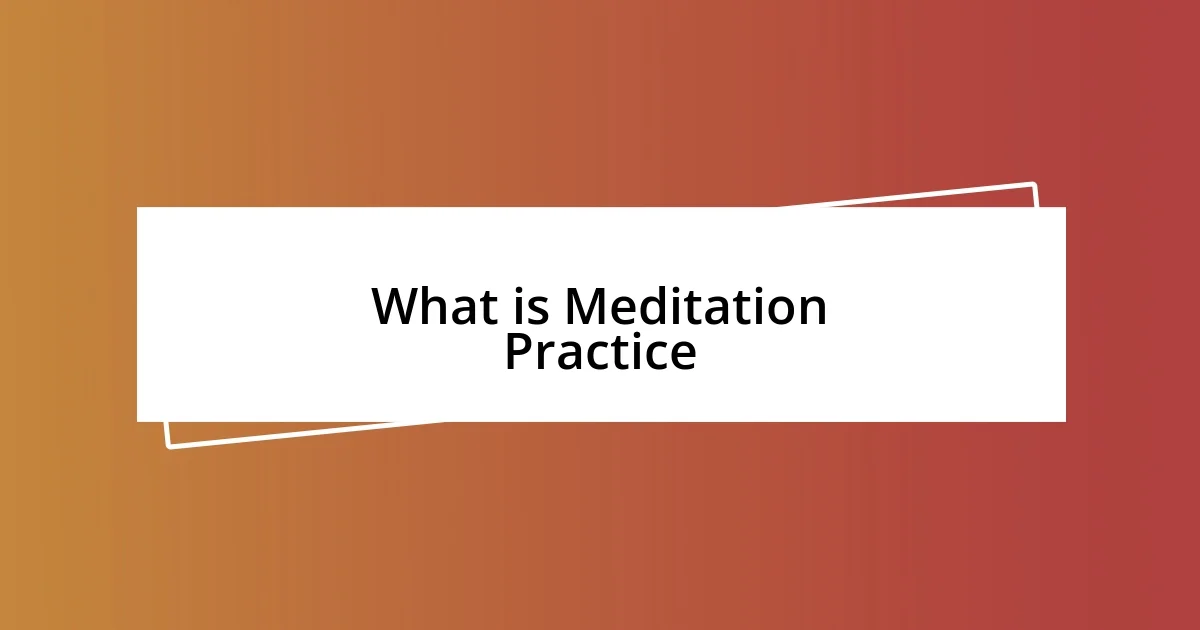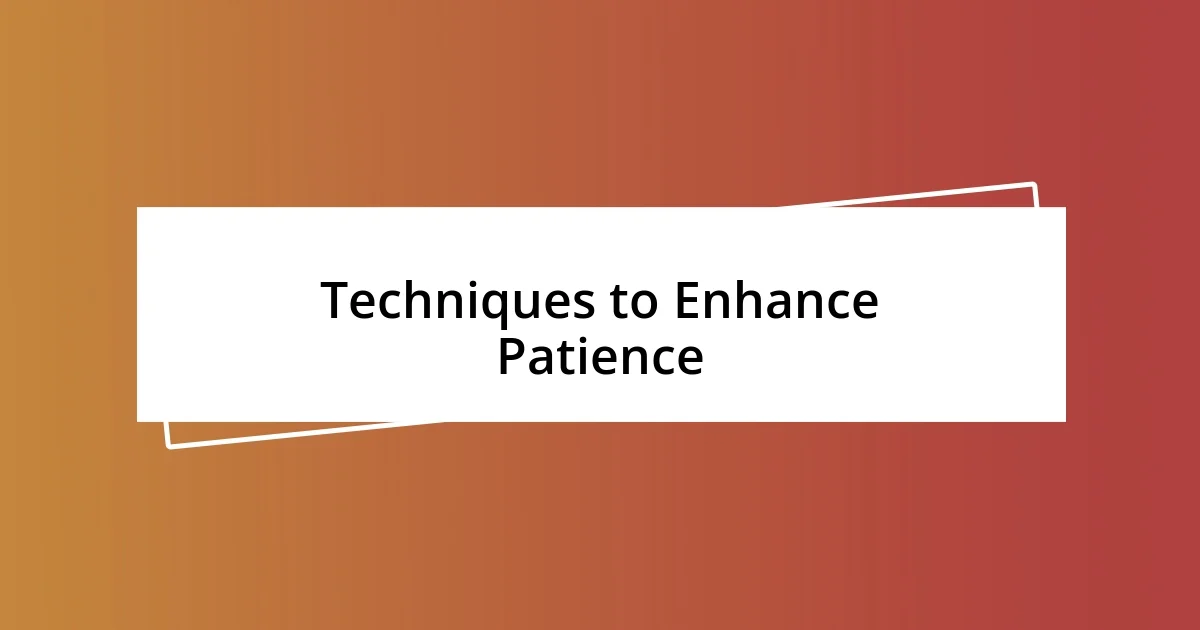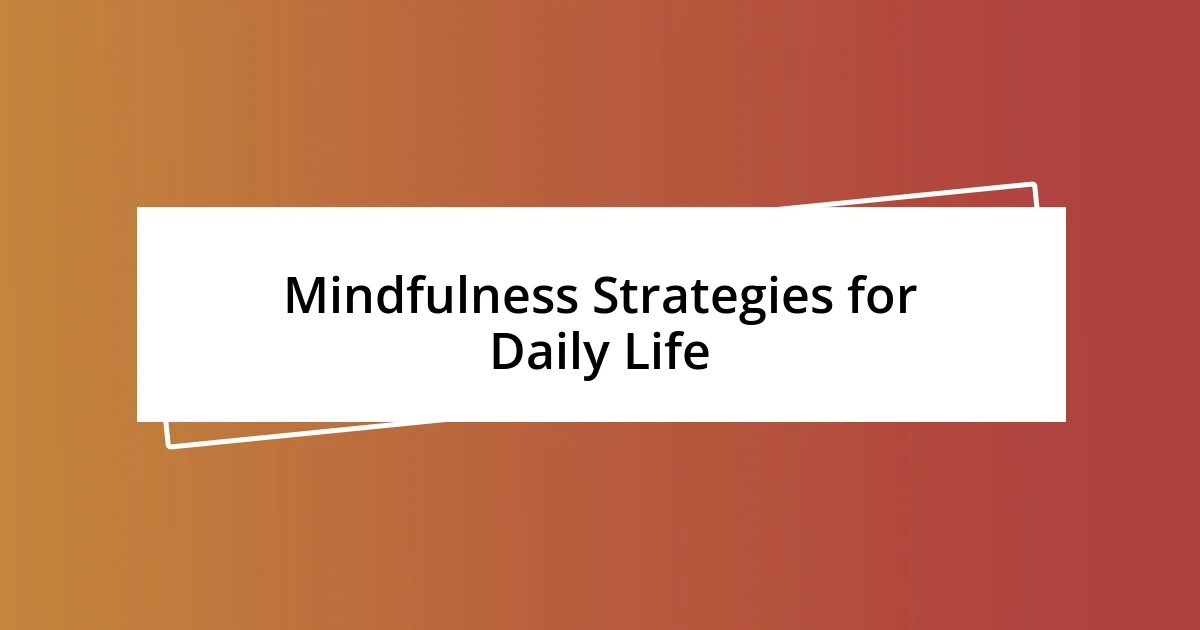Key takeaways:
- Meditation fosters patience by cultivating awareness and emotional regulation, allowing thoughtful responses to stress instead of impulsive reactions.
- Mindfulness strategies, such as breath counting and mindful eating, help integrate patience into daily life, transforming ordinary moments into opportunities for reflection.
- Personal growth through patience involves celebrating small victories, embracing setbacks as part of the learning process, and applying these lessons in everyday interactions for deeper connections.

What is Meditation Practice
Meditation practice is a journey into the depths of one’s own mind, and I’ve found that it often feels like stepping into a quiet library where I get to explore my thoughts without judgment. Each session invites me to sit still and observe my racing thoughts, almost like watching clouds drift by in the sky. I remember when I first started; I struggled just to keep my focus for a few minutes – it was both frustrating and eye-opening.
At its core, meditation is not just about sitting in silence; it’s about cultivating awareness and presence amidst the chaos of daily life. Have you ever noticed how difficult it can be to simply be? I recall a moment during my practice where I realized the importance of just breathing and allowing myself to feel all the messy emotions swirling within. It was a liberating experience that shifted my perspective on patience.
With regular practice, I discovered that meditation encourages a deeper connection to my inner self, allowing me to understand my reactions and emotions more clearly. Each session feels like peeling back layers of an onion, revealing insights that spark joy or discomfort. It’s amazing how a few minutes of stillness can illuminate paths I hadn’t seen before. Do you find that those quiet moments help you to better navigate life’s challenges? I certainly have.

Benefits of Meditation for Patience
Meditation has profoundly enhanced my ability to cultivate patience, teaching me that it’s essential to embrace the present rather than rush through it. I vividly remember a time when I faced a challenging situation, and instead of reacting impulsively, I took a moment to breathe and center myself. This pause allowed me to respond thoughtfully rather than react in frustration, a revelation that transformed my approach to everyday stressors.
Through consistent practice, I found that meditation sharpens my awareness, allowing me to notice my impatience before it manifests into action. One morning, while sitting in silence, I noticed the urge to check my phone and the impatience creeping in. Instead of succumbing to that impulse, I redirected my focus back to my breath, reminding myself that every second is a gift. Each moment spent in meditation reinforces my ability to remain calm amidst the storm of life.
What truly amazes me is how meditation provides a space to understand the underlying causes of impatience. I recall an instance during a particularly chaotic day when everything felt overwhelming. Instead of getting frustrated, I took a brief meditation break. By observing my thoughts without judgment, I discovered that my impatience stemmed from unrealistic expectations. This insight was a game changer, revealing how mindfulness can turn impatience into opportunity for growth and understanding.
| Benefit of Meditation | Impact on Patience |
|---|---|
| Increased Awareness | Helps identify feelings of impatience before reacting |
| Emotional Regulation | Encourages thoughtful responses to stressors |
| Deepened Understanding | Reveals root causes of impatience |

Techniques to Enhance Patience
One of the most effective ways I’ve discovered to enhance patience is through mindful breathing exercises. Initially, I struggled with the idea of just sitting and focusing on my breath. However, I soon realized that taking deep, intentional breaths creates a pocket of calm in my otherwise hectic day. This simple act allows me to anchor myself, especially in moments when impatience begins to rear its head. It’s almost like pressing pause on life for a brief moment.
To further develop this skill, here are a few techniques I’ve found helpful:
- Breath Counting: Inhale deeply for a count of four, hold for four, and exhale for four. This rhythm fosters focus and slows the mind.
- Body Scan: Gradually shift your focus through different parts of your body, observing any tension or discomfort. This promotes relaxation and creates awareness of how impatience often manifests physically.
- Guided Meditation: Using apps or online resources, I find that following narrated sessions helps keep my mind engaged, making it easier to cultivate patience over time.
Integrating these practices has transformed how I navigate challenging situations. Just the other day, while waiting in a long line, I felt my impatience bubbling up. Instead of fidgeting or checking my watch, I connected with my breath and visualized letting go of that tension. It’s remarkable how these techniques have shifted my perspective, reinforcing the idea that patience isn’t merely the absence of annoyance—it’s an active practice of self-awareness and acceptance.

Mindfulness Strategies for Daily Life
Mindfulness strategies can seamlessly fit into daily life, often in the smallest of moments. I remember a particularly hectic morning when I found myself rushing to get out the door. Instead of letting the chaos dictate my mood, I paused at the front door to take three slow, mindful breaths. This brief interlude not only grounded me but also helped me appreciate the beauty of that moment, turning an ordinary routine into intentional practice. Isn’t it surprising how just a couple of breaths can change your entire day?
Another strategy I’ve deeply embraced is mindful eating. I used to bolt my meals, barely tasting my food. But then, I decided to slow down. By focusing on each bite—the flavors, the textures, even the colors of the food—I not only savored my meals but also created an opportunity for patience to seep into my other activities. For me, this practice became a gentle reminder that life’s richness often lies in the details. How often do we overlook those details in our fast-paced world?
Additionally, I’ve devoted a few minutes each day to the simple act of observing nature, whether it’s a tree swaying gently in the wind or birds flitting about. I find that taking these moments to intentionally notice my surroundings fosters a profound sense of patience. I recall an afternoon when I dedicated just five minutes to watch clouds drift by. It felt like time stood still, pulling me back from my hectic thoughts. That experience encouraged me to carry that same mindful observation into my interactions with others. Have you ever tried just observing without judgment? The insights can be surprisingly enriching.

Overcoming Challenges in Meditation
Meditation often presents challenges that can test our resolve. I vividly remember a session where my mind was racing with thoughts about my to-do list. Instead of becoming frustrated, I chose to gently acknowledge those distractions without judgment. This realization—allowing thoughts to float by like clouds—was a game-changer. Have you ever noticed how letting go of resistance can transform a frustrating experience into a moment of clarity?
Another obstacle I encountered was physical discomfort during meditation. Early on, my back would ache, and I found it nearly impossible to stay still. Then, I discovered the power of adjusting my posture and using props like cushions. Making these small tweaks not only alleviated my discomfort but also deepened my commitment to the practice. It taught me that accommodating my needs in meditation is essential for cultivating patience. Isn’t it interesting how listening to our bodies can open up new pathways for growth?
Moreover, the ever-present temptation to check the time during my sessions became a frustrating hurdle. I remember sitting there, glancing at my watch, counting down the minutes rather than embracing the practice. One day, I decided to turn my phone face down and simply trust the process. That decision shifted my experience entirely; without the pressure of time, I felt freer and more open to whatever arose. How often do we allow external pressures to dictate our inner calm? In my experience, meditation transforms the concept of time itself, inviting us to become present in each moment.

Personal Growth Through Patience
I’ve learned that personal growth often blooms in the fertile ground of patience. One afternoon, I found myself waiting for a friend who was running late. Instead of letting frustration bubble up, I turned to my breath, feeling the rhythm of each inhale and exhale. In that stillness, I realized that waiting didn’t have to be wasted time; it was a chance to reflect and connect with my thoughts. Have you ever found strength in simply being present?
There was a time when I struggled with impatience during challenging projects. I remember attempting to learn a new skill and feeling overwhelmed when progress seemed slow. It was disheartening, but I began to see setbacks as natural parts of the learning process. Embracing this perspective fueled my understanding that growth often requires time and repeated effort. It makes me wonder, don’t we all need that gentle reminder that progress isn’t always linear?
Another moment of insight came when I attempted to implement new habits in my daily routine. Instead of expecting immediate results, I started celebrating small victories along the way. I’ll never forget the joy of finally mastering a meditation posture after weeks of inconsistency. This experience taught me that patience is not just about waiting; it’s about cultivating appreciation for the journey itself. How often do we forget to honor the small steps that lead us to greater achievements?

Applying Patience Beyond Meditation
Patience is a lesson that extends far beyond my meditation mat. I recall during a family gathering, the conversation took a heated turn, and rather than reacting impulsively, I took a moment to breathe and absorb the situation. This conscious pause reminded me that sometimes, the best response is to give others the space to express themselves, helping to defuse tension instead of escalating it. Have you ever noticed how a little breathing room can lead to better understanding?
During my workdays, there are moments when deadlines loom, and stress levels rise. I found myself rushing through tasks, but I learned that taking brief pauses to refocus can actually enhance my productivity. One particularly hectic afternoon, I stepped outside for a moment, allowing myself to recharge. I came back with a clearer mind and renewed energy, proving to me that patience isn’t merely about waiting; it’s also about recognizing when to recalibrate and approach challenges with fresh eyes. How often do we push through without realizing that stepping back can be just as powerful?
In my experience, building patience in everyday interactions has transformed the way I connect with others. I remember a time when a friend shared their struggles, and instead of jumping in with solutions, I focused on listening. In that silence, empathy grew, and my friend felt truly heard. This taught me that patience isn’t just about time; it’s about giving people the space they need to share their stories. Don’t we all crave that kind of understanding from one another?













